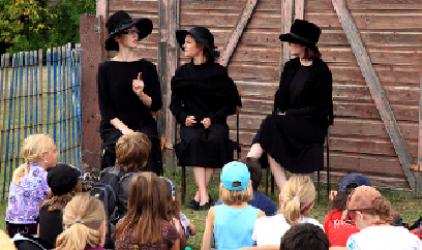La Société historique de la Saskatchewan Heritage Days 2009

Les Journées du patrimoine/Heritage Days 2009 were held on September 18th and 19th 2009 on Duck Lake’s Victoria and Front Streets. A total of 1115 visitors of all ages came to the event during the two days. On Friday, September 18th (our school day) 878 students from Fransaskois, French immersion and three Anglophone schools attended our event. The students were accompanied by 90 teachers and chaperons. On Saturday, September 19th (our general public day), 147 visitors from the general public came to Journées du patrimoine/Heritage Days 2009.
Our event had record number for the North of the province of students and schools attending. A total of seven Fransaskois schools participated, six from the North and one from the South. Six French Immersion schools attended, as well as three Anglophone schools from the Duck Lake region. As for the general public, visitors were generally from Prince Albert, Saskatoon, Debden, Bellevue, St-Denis and the Duck Lake region.
The main attraction of Journées du patrimoine/Heritage Days 2009 was the presentation of the historical sketches. Fifteen sketches were presented along Victoria Street where visitors were able to travel back to 1912 and experience life at the beginning of the 20th century. The sketches discussed everyday life and the interactions between the French speaking people and people from different cultural backgrounds. They depicted what was happening in the world, specifically Duck Lake, at this time. For example, one sketch demonstrated the suffragette movement, while another illustrated the impact of colonization. Others were about local people and local organizations, for example Louis Schmidt, the ACFC, and the newspaper Patriote de l’Ouest.
Traditional skills, like previous years, were part of Journées du patrimoine/Heritage Days 2009. One presentation was that of the blacksmith and ironwork. A second presentation showed visitors how to make butter and children were invited to help out. Finally there was a presentation on quilting and knitting. The presenters explained the history of traditional materials and fabrics that were used in the past.
Journées du patrimoine/Heritage Days included a few activities for younger viewers. A puppet theater, The Pioneers, was presented by the troupe Marie Stella. This puppet show depicted the story of the Quebecois’ who were leaving Quebec to establish in Western Canada. In addition, the event showcased storytelling by Simon Moccasin. Children even had the opportunity to play games of yesteryears, such as, Simon Says, Duck Duck Goose, marbles, skipping rope, hopscotch and Capture the Flag.
Again this year we had a kiosk information area with presentations from Archives de Bellevue, Parks Canada, and Saskatchewan Archeological Society.
The success of such an event would be impossible without our volunteers. In 2009, 85 volunteers helped us recreate 1912 on Duck Lake’s Victoria and Front Streets. They took on roles such as actors, guides, admissions, traffic control, leaders of games of yesteryears and ancestral skill demonstrators.
We produced our fourth edition of the teacher’s guide, L’histoire fransaskoise à portée de la main (or Fransaskois History at Your Fingertips). We sent 600 of them to Fransaskois and French Immersion Schools throughout Saskatchewan. Each school received between 3 and 5 teacher’s guides at the beginning of the school year (September 2009). The teacher’s guide gives detailed information of all the themes present in the sketches that are performed during Journées du patrimoine/Heritage Days. It helps foster a better understanding of Saskatchewan and Fransaskois history. According to the student and teacher evaluation forms, the majority responded that they did in fact use the teacher’s guide prior to visiting Journées du patrimoine/Heritage Days 2009 and the guide did aid their learning process.
This event was a positive experience for all visitors. It gave them the chance to interactively learn about the history of Saskatchewan, more specifically they learned about everyday life in Duck Lake, 1912. They learned about the contributions the French-speaking people made to help build their province. Visitors also discovered that numerous communities and many different cultures helped make Saskatchewan what it is today.
La Société historique de la Saskatchewan would like to thank THEN/HIER for they helped make possible the creation of the teacher’s guide, Fransaskois History at Your Fingertips.

